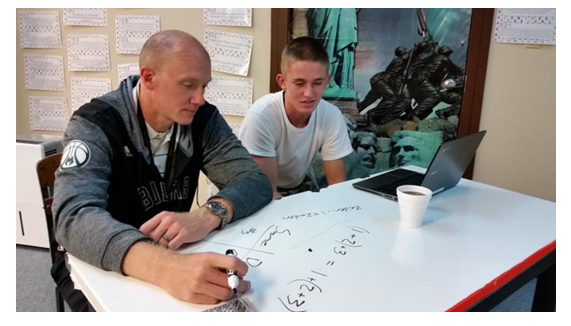Robert Glenn is a math teacher at St. John’s Military School. In an effort to better accommodate the needs of his students, Glenn has taken an innovative, and effective approach to teaching by implementing what is known as a “flipped classroom.” Under the flipped model, Glenn’s lectures and homework course elements are reversed, with students being assigned video lectures to be viewed in the barracks before the next class session, while in-class time is devoted to exercises, practice, and one-on-one guidance. Glenn’s flipped model is making an impactful difference in teaching his cadets the importance of independent learning and responsibility, and is giving them the individualized attention they need to succeed.
When asked what inspired him to implement a flipped classroom model, Glenn pointed to the proliferation of digital content and the era of on-demand information that young people live in today.
“It used to be that a teacher was his students’ knowledge base,” said Glenn. “After all, they were the ones in the front of the classroom disseminating information, but that isn’t the case anymore. Today, Google knows more than I do. It’s easy for students to answer even trivial questions by simply looking up the information on their phones. Today, the accessibility of information is making it difficult for students to sit for long periods of time in a lecture setting. I’ve been teaching for over 11 years, and I could see that the traditional lecture format was no longer working as well as it had in the past. I knew I needed to try something new.”
The flipped classroom draws on such concepts as active learning and student engagement. The value of the flipped classroom model is in the repurposing of class time into an active practice session where students can apply their knowledge, test their skills, receive individualized instructor guidance, and interact with one another in hands-on activities.
According to online learning provider Sophia, 9 out of 10 teachers noticed a positive change in student engagement after implementing a flipped model, and 71 percent of teachers indicated that their students’ grades had improved as well. Flipped classroom teachers also report that a majority of students with special needs, as well as those in advanced placement classes, particularly benefit from flipped learning.
To help keep his students engaged in learning, and to offer them a more individualized classroom experience, Glenn implemented the flipped classroom model at St. John’s Military School. He now records his lectures in advance as videos and instructs his students to watch an assigned video before each class period. When students arrive in class, having already watched Glenn’s lecture via the video viewing assignment, Glenn can actively work with his students to put into practice the concepts explained in the video lecture.
“The flipped classroom model turns the responsibility of learning over to the student,” said Glenn. “It gives my students more flexibility, and enables a greater sense of ownership over each assignment, as well as their overall success. It gives me more flexibility as well. Without a pre-defined lecture that needs to be covered, I can adapt to meet the needs of my students during each class session. We can spend time as a group, or in smaller teams, on just those concepts that need further explanation.”
After implementing the flipped classroom model, Glenn has seen particular improvements in those students who had previously struggled to focus during class lectures.
“You can’t pause a live lecture,” said Glenn. “Too often a student may miss an important concept because he’s still writing a note about the last important point that was made. If that student isn’t comfortable asking me to stop and repeat myself, he may become lost. With the pre-recorded videos, he can pause the video whenever he wants while taking notes, and can re-watch segments as needed until he fully understands a concept. This allows students to learn at their own pace, which is incredibly important to their overall success.”
The flipped classroom model is just one initiative being implemented by faculty and staff at St. John’s Military School to provide a more individualized, and more active learning experience to cadets. St. John’s Military School strives to prepare young men for college and the workplace by teaching them the importance of personal responsibility, integrity, teamwork, and leadership, all skills that are reinforced by the flipped classroom model.
“At. St. John’s Military School, we teach a lot of the soft skills that are more difficult to effectively teach in the public school environment because there are so many students. At St. John’s Military School however, we are able to teach such important skills as collaboration, teamwork, and how to problem solve effectively in order to get a job done.”
Glenn points to the success of his students as evidence of the flipped classroom’s effectiveness.
“I’ve seen a lot of students make significant progress after implementing the flipped classroom. Just this summer alone we had three cadets who were struggling to get the math credits they needed to graduate. We implemented the flipped model, and they are all on track now. If I had just stood at the front of the room and lectured at them all summer, they may not have gotten there. Implementing this process has been a rewarding learning experience for me, and as a teacher, that is all you can ask for.”
—
Story from Melissa McCoy / St. John’s Military School



